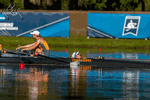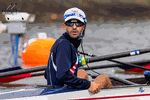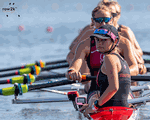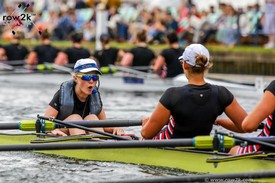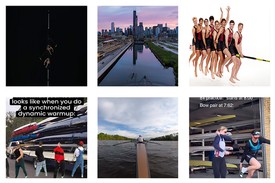In the Driver's Seat, with Sammy Houdaigui
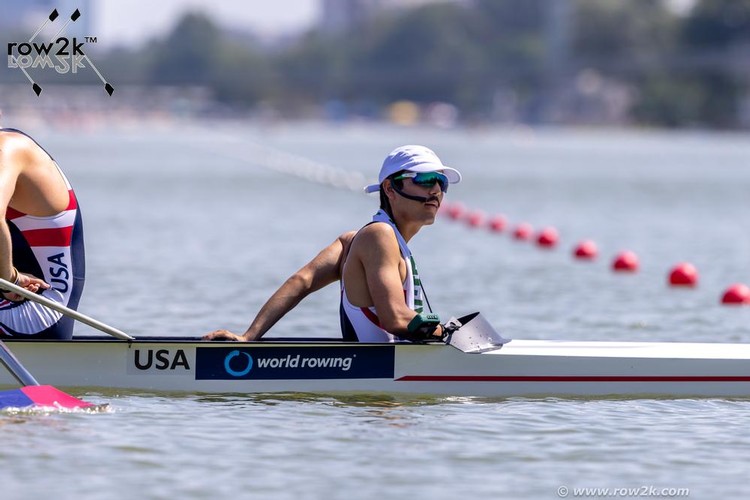
Next up In The Driver's Seat--where we hear from the folks who keep the shells straight and the crews fast—-is coxswain Sammy Houdaigui.
Sammy just started his junior year with the Dartmouth Heavyweights, where he has been coxing the Varsity Eight for two seasons already, including both the Big Green's second place finish at the 2021 Head Of The Charles and the Dartmouth 1V's Eastern Sprints bronze in 2022.
Internationally, Sammy coxed the 2023 U23 Men's Four to a thrilling bronze medal in Plovdiv this past summer, on the same course where he competed on the US Junior National Team in 2021 just before heading to Dartmouth--also in the coxed four.
Let's hop In The Driver's Seat with Sammy:
row2k - What do you see as the three most important things for being a successful coxswain?
Sammy Houdaigui - Chiefly, it's steering. I don't think that the importance of steering can be overstated--it's what we live or die by as a coxswain--and I roll the safety component that's also talked about into steering as well: just understanding where the boat is in practice situations. Then, in a race situation, steering is critical. We like to think of a head race as the only time when a coxswain's steering can really have an impact on the race result, but I challenge that narrative a little bit: it’s just as crucial to a 2k. In those situations, if you're letting the boat wiggle around, side to side, then you're constantly on the rudder to adjust, putting the brakes on, and you're adding upwards of 20 meters.
If you can keep the course near perfect, and stay off the rudder as much as possible, that's going to have a huge impact on the overall result--and when you do adjust on the rudder, it's not a major adjustment. It's the smallest possible motion on the tiller, something that's happening while the blades are in the water.

The second major essential is understanding cause and effect. The lens I've developed as a coxswain for all my calls is: "what is the effect that I'm trying to get out of the words coming out of my mouth?" Once you start to do that, you realize that a lot of what you're saying is just fluff. "Am I making this call because I'm actually seeing something in the boat? Or am I just making this call to fill space and because I think it sounds good?" Silence is a perfectly fine thing, even in a race: two strokes of silence can be powerful. But then, when you are back on the mic, it is about understanding what you are trying to get out of this technical call or that race plan call--being very intentional with what you say.
The last component would be understanding what you're getting yourself into in terms of the race course. In a head race situation, you need to know every inch of that course. In a 2k situation, it's really important knowing the course that you're at as well. I think one of the major things that made this national team cycle a little bit more successful for me on a personal level was my familiarity with Plovdiv. I'd been there with the U19 team, and so I knew the race warm-up, I knew what it was going to feel like and whether it was going to be crowded during practice days. I could ask myself, where do I need to be a little bit more aggressive? What's the best stretch to do our practice moves on? If you're launching for a 2k race and you don't even know where the warmup zone is, you can't deliver an effective warm up--and delivering an effective warm up for a 2k race day is as important as anything you're going to do during the actual race.
row2k - What is your favorite drill to run with your crews? Any tips on how to the drill well, for maximum effectiveness?
Sammy Houdaigui - The Dead Mosquito Drill. That's where you have half the boat or even up to six guys put their handles on the gunwhale, and then just have two or four guys row and set the boat with their strokes.
It's just such an impactful drill, because the guys are learning from it in real time.

The key to running that drill--and this can be said for any drill--is figuring out what the one change is that you actually want to see happen and then to look for that specific change. For Dead Mosquito, let's say the boat's really rolling and I'm thinking that a brighter catch from these guys could stop that roll. The drill becomes an opportunity to show them that cause and effect. So you're talking about a quicker catch, and then once they get it, the boat stops rolling. Then you have a really powerful tool that you can pull out of your pocket in a race situation or during a piece, because now you can tell whoever it is to use his 'Dead Mosquito catch.' It's not just a drill for the sake of doing a drill, but something you can reference in that game-time moment.
row2k - What's some of the best coaching advice you've received about your coxing?
Sammy Houdaigui - I'll spin this question a little bit: Henry Fieldman, who coxes the British Eight, is a really amazing coxswain and a friend. He mentioned that the best sessions for him are when he sees the coach going to grab the megaphone, and he makes a call first so that a change happens and the coach just puts the megaphone down. That's his bar for every one of his calls: he wants it to be something that that the coach was seeing and would have called, but it's no longer necessary because he made that change from the coxswain seat.
That's a pretty high bar. It seems simple enough, but there's a reason why the coaches are coaches. Still if you hold yourself to that standard, you are going to be really impactful during your practice.

row2k - What is a mid-race call or move that you've made that you'll remember for the rest of your life? It doesn't have to be this year's U23 Four race, where your crew went from trailing in 6th, in the outside lane, up into the medals over the last 1000 of the race, but that would be a great move to hear more about.
Sammy Houdaigui - I do have to go with that fours race, and that decision to lift at the 800. That was something that every guy bought into and that move was just total outside smoke.
You have to go into a race at that level embracing American confidence and act like you own the world because you feel like you do. When we made that move, we started taking one seat a stroke on every single boat, and I don't even think that was the big moment. The big moment was after we started doing that, when I told the guys it's got to be this speed from here on out. If we want a medal, this is the new standard and then them buying into it for 1200 meters.
[ed. note: you can watch the video with a recording of Sammy starting to call that move here on Youtube]
row2k - Can you tell us what you've learned about how to cox a land practice or erg tests?
Sammy Houdaigui - There's a lot of land training at Dartmouth, and I'd say that as a coxswain you have to stay fit yourself. I'm a real believer that the idea that a coxswain needs to be about yelling and motivation just isn't the case at the college level. An athlete rowing at Dartmouth is internally motivated. So on the water or on land, you don't need to be in their ear screaming 24/7.

My time in the winter is about weight management and trying to stay fit. It's a lot of biking for me, and whether you're doing that during the practices or at whatever time is going to be best for your schedule, do what you need to do on a personal level to stay fit and make weight.
At Dartmouth, we're very fortunate that we have the indoor tanks, so there is still an opportunity for me to work on facilitating technique and changes during the winter. Then, in the fall, we do a lot of small boat rowing where I'm in the launch. I think a lot of coxswains look at time in the launch as a waste of a session, but that couldn't be farther from the truth. Time in the launch is really impactful, because it's your opportunity to get to understand and write down everything that the coach is saying. If I'm in a launch, I'm writing down everything that Coach Wyatt Allen is calling and then those are going to be things that I can integrate when I'm on the water. You're also seeing your guys from a different perspective, one where you can actually tell everything that's going on. That's critical, and I jot down notes about that, too.
row2k - Tell us a bit about your best race/practice?
Sammy Houdaigui - I would say that any successful practice is just a really purposeful practice. For instance, any time that we head out to Lake Morey, which looks like Lake Lucerne and is this really beautiful venue that we have access to here at Dartmouth, I just know that it's going to be a really purposeful session. We don't go out there for no reason; we go when we want to do that really close seat race or a bit of final preparation. Going out there is just fantastic because it gives us a race day routine: we're not in our boathouse, we're using a trailer, and we're going through the motions of a race day.

row2k - How about your worst race or practice? Sammy Houdaigui - Any race where I've gotten off the water and felt like I didn't perform well individually, while you just hate it so much in the moment, that for me is what keeps me going. In 2021, when we got fourth in the U19 coxed four, I didn't get off the water feeling like I had my best performance. That became something I used to motivate me to constantly improve for the next year. As a coxswain, you don't have an erg test that tells you that you got this much faster. You can be almost blind to the improvement you make because it is so incremental. Then when you do have a race where you get off and you can say, I performed to the best of my abilities, there's a great level of satisfaction to that.
Thanks for riding along with Sammy -- and, remember, this column is open to all "drivers" out there, so if you are an experienced coxswain at any level--from juniors to masters--and would be willing to invite row2k to join you in your ride, just contact us here. We’d love to hear from you about what you see from the Driver's Seat.

If you enjoy and rely on row2k, we need your help to be able to keep doing all this. Though row2k sometimes looks like a big, outside-funded operation, it mainly runs on enthusiasm and grit. Help us keep it coming, thank you! Learn more.
Comments | Log in to comment |
There are no Comments yet
| |
- Bont Rowing
- Calm Waters Rowing
- Concept 2
- Craftsbury Sculling
- The Crew Classic
- CrewLAB
- Croker
- Dad Vail Regatta
- Durham Boat Co.
- Empacher
- Faster Masters
- Filippi
- Fluidesign
- h2row.net
- HUDSON
- myrow
- Nielsen-Kellerman
- Oak Ridge RA
- Peinert Boat Works
- Pocock Racing Shells
- Race1 USA
- Rockland Rowing Masters Regatta
- RowKraft
- Rubini Jewelers
- Vespoli USA
- WinTech Racing
- Bont Rowing
- Calm Waters Rowing
- Concept 2
- Craftsbury Sculling
- The Crew Classic
- CrewLAB
- Croker
- Dad Vail Regatta
- Durham Boat Co.
- Empacher
- Faster Masters
- Filippi
- Fluidesign
- h2row.net
- HUDSON
- myrow
- Nielsen-Kellerman
- Oak Ridge RA
- Peinert Boat Works
- Pocock Racing Shells
- Race1 USA
- Rockland Rowing Masters Regatta
- RowKraft
- Rubini Jewelers
- Vespoli USA
- WinTech Racing



